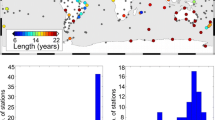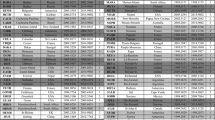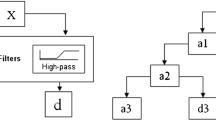Abstract
Global Navigation Satellite System (GNSS) observations play an important role in climate studies because of the advantages they provide. An analysis of the GNSS observations can be used to obtain the zenith total delay (ZTD) parameter, which represents the effect of weather conditions. In this study, the trends of the time series of IGS (International GNSS Service) Repro1 ZTD data recorded between 1995 and 2010 at 19 GNSS stations throughout Turkey and Europe reprocessed in the framework of COST Action ES1206 were investigated. The trends of the time series were estimated by using the Mann–Kendall rank correlation test in addition to Spearman’s rho test and Sen’s slope method. In addition, the Run (Swed–Eisenhart) test was performed to test for homogeneity. The aim of this study was to evaluate the advantages and disadvantages of the applications of different methods to the estimation of trends in the ZTD time series. According to the Mann–Kendall rank correlation test, the ANKR, GRAS, HERS and MAS1 stations exhibited an increasing trend. Using the Spearman rho test, increasing trends were observed at the ANKR, EBRE and MAS1 stations, while decreasing trends were observed at the BRUS and GRAS stations. Finally, negative slope values were obtained at the BRUS, GRAS, GRAZ, HERS, JOZE, PENC and WTZR stations by using the Sen slope method.












Similar content being viewed by others
References
Agha OMAM, Şarlak N (2016) Spatial and temporal patterns of climate variables in Iraq. Arab J Geosci 9:302. https://doi.org/10.1007/s12517-016-2324-y
Baldysz Z, Nykiel G, Araszkiewicz A, Figurski M, Szafranek K (2016) Comparison of GPS tropospheric delays derived from two consecutive EPN reprocessing campaigns from the point of view of climate monitoring. Atmos Meas Tech 9:4861−4877. https://doi.org/10.5194/amt-9-4861-2016
Baldysz Z, Nykiel G, Figurski M, Araszkiewicz A (2018) Assessment of the impact of GNSS processing strategies on the long-term parameters of 20 years IWV time series. Remote Sens 10(496):1–25. https://doi.org/10.3390/rs10040496
Bevis M, Businger S, Herring TA, Rocken C, Anthes RA, Ware RH (1992) GPS meteorology: remote sensing of atmospheric water vapour using the global positioning system. J Geophys Res 97(D14):15787–15801
Bianchi CE, Mendoza LPO, Fernandez LI, Natali MP, Meza AM, Moirano JF (2016) Multi-year GNSS monitoring of atmospheric IWV over Central and South America for climate studies. Ann.Geophys. 34:623–639
COST (2012) Memorandum of understanding for the implementation of a European concerted research action, COST Action ES1206. Advanced Global Navigation Satellite Systems Tropospheric products for monitoring severe weather events and climate (GNSS4SWEC). European Cooperation in Science and Technology,November,Brussels.
Demircan M, Arabacı H, Coşkun M, Türkoğlu N, Çiçek İ (2016) Monthly distribution patterns of temperature. TÜCAUM 2016 International Geography Symposium, October, Ankara, Turkey, Proceedings: 98-105.
Dousa J, Vaclavovic P, Elias M (2017) Tropospheric products of the second GOP European GNSS reprocessing (1996–2014). Atmos Meas Tech 10:3589–3607. https://doi.org/10.5194/amt-10-3589-2017
Gocic M, Trajkovic S (2013) Analysis of changes in meteorological variables using Mann-Kendall and Sen’s slope estimator statistical tests in Serbia. Glob Planet Chang 100:172–182
Guerova G (2015) Exploitation of ground-based GNSS for meteorology and climate studies in Bulgaria/South-Eastern Europe. FIG Working Week 2015, May, Sofia, Bulgaria, Proceedings: 1−8.
Gümüş V (2006) Evaluation of Fırat River Basin streamflow by trend analysis. Master of Science Thesis. Harran University, Natural Science Institute, Şanlıurfa, Turkey.
Jin S, Park J, Cho J, Park P (2007) Seasonal variability of GPS-derived zenith tropospheric delay (1994-2006) and climate implications. J Geophys Res 112:D09110. https://doi.org/10.1029/2006JD007772
Kousari MR, Zarch MAA (2010) Minimum, maximum and mean annual temperatures, relative humidity and precipitation trends in arid and semi-arid regions of Iran. Arab J Geosci 4:907–914. https://doi.org/10.1007/s12517-009-0113-6
Olofintoye O, Adeyemo J, Otieno F (2012) Impact of regional climate change on freshwater resources and operation of the Vanderkloof Dam system in South Africa. Global Warming-Impact and Future Perspective, Chapter 6, Rijeka, Croatia, pp 165−184. https://doi.org/10.5772/50414
Pacione R, Araszkiewicz A, Brockmann E, Dousa J (2017) EPN-Repro2: a reference GNSS tropospheric data set over Europe. Atmos Meas Tech 10:1689–1705. https://doi.org/10.5194/amt-10-1689-2017
Refat Nasher NM, Uddin MN (2013) Maximum and minimum temperature trends variation over Northern and Southern part of Bangladesh. J Environ Sci Nat Resour 6(2):83–88
Rocken C, Hove TV, Johnson J, Solheim F, Ware R, Bevis M, Chiswell S, Businger S (1994) GPS/STORM-GPS sensing of atmospheric water vapor for meteorology. J Atmos Ocean Technol 12:468–478
Sen PK (1968) Estimates of the regression coefficient based on Kendall’s tau. JASA. 63:1379–1389. https://doi.org/10.2307/2285891
Sneyers R (1990) On the Statistical analysis of series of observations, vol 143. WMO Technical Note, Genova, p 192
Swed FS, Eisenhart C (1943) Tables for testing randomness of grouping in a sequence of alternatives. Ann Math Stat 14:66–87
Yadav G, Mishra N, Prashanthi K, Chaturvedi S (2015) Air pollution trend analysis using Sen estimator method-a survey. IJSR 4(3):71–76
Acknowledgements
We would like to acknowledge Dr. Olivier BOCK, IGN, France, for making the IWV data from IGS repro1 and ERA-Interim available. These data were prepared and quality-checked in the framework of COST Action ES1206, GNSS4SWEC.
Author information
Authors and Affiliations
Corresponding author
Additional information
Editorial handling: Nilanchal Patel
Appendices
Appendix 1. Detailed results of Mann–Kendall rank correlation method
Appendix 2. Detailed results of Sen’s slope method
Rights and permissions
About this article
Cite this article
Beşel, C., Tanır Kayıkçı, E. Trend estimation of zenith total delays at IGS stations by using nonparametric methods. Arab J Geosci 12, 547 (2019). https://doi.org/10.1007/s12517-019-4609-4
Received:
Accepted:
Published:
DOI: https://doi.org/10.1007/s12517-019-4609-4







